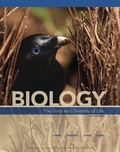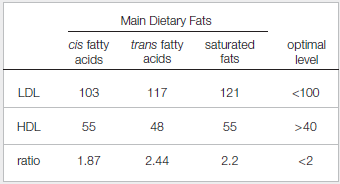
Concept explainers
Effects of Dietary Fats on Lipoprotein Levels
Cholesterol that is made by the liver or that enters the body from food cannot dissolve in blood, so it is carried through the bloodstream in clumps called lipoprotein particles. Low-density lipoprotein (LDL) particles carry cholesterol to body tissues such as artery walls, where they can form deposits associated with cardiovascular disease. Thus, LDL is often called “bad” cholesterol. High-density lipoprotein (HDL) particles carry cholesterol away from tissues to the liver for disposal, so HDL is often called “good” cholesterol. In 1990, Ronald Mensink and Martijn Katan published a study that tested the effects of different dietary fats on blood lipoprotein levels. Their results are shown in FIGURE 3.2.
FIGURE 3.2 Effect of diet on lipoprotein levels. Researchers placed 59 men and women on a diet in which 10 percent of their daily energy intake consisted of cis fatty acids, trans fatty acids, or saturated fats.
The amounts of LDL and HDL in the blood were measured after three weeks on the diet; averaged results are shown in mg/dL (milligrams per deciliter of blood). All subjects were tested on each of the diets. The ratio of LDL to HDL is also shown.

In which group was the level of LDL (“bad” cholesterol) highest?
To explain: The group that had the highest level of LDL (“bad” cholesterol).
Concept introduction: Lipoproteins are carriers of hydrophobic molecules in the extracellular matrix and the blood. The lipoproteins are made of phospholipids, cholesterol, and proteins. The proteins are made of amino acids. Low-density lipoprotein (LDL) transports fat, essentially cholesterol molecules in aqueous medium. LDL can get oxidized with arterial walls and forms plaque. Saturated fatty acids have fatty acid chains lacking double bonds between their carbon atoms.
Explanation of Solution
In the experiment, the amount of LDL was checked in three groups of main dietary fats: cis fatty acids, trans fatty acids, and saturated fats. Their optimal levels were also checked. The optimal level of LDL is lesser than 100. The amount of LDL in cis fatty acids is 103, trans fatty acids is 117, and saturated fats is 121.
The saturated fats had the highest level of LDL also known as bad cholesterol among the three groups.
Want to see more full solutions like this?
Chapter 3 Solutions
Biology: The Unity and Diversity of Life (MindTap Course List)
Additional Science Textbook Solutions
Genetics: From Genes to Genomes, 5th edition
Microbiology: An Introduction
Marine Biology (Botany, Zoology, Ecology and Evolution)
Becker's World of the Cell (9th Edition)
Human Physiology: An Integrated Approach (7th Edition)
- Effects of Dietary Fats on Lipoprotein Levels Cholesterol that is made by the liver or that enters the body from food does not dissolve in blood, so it is carried through the bloodstream by lipoproteins. Low-density lipoprotein (LDL) carries cholesterol to body tissues such as artery walls, where it can form deposits associated with cardiovascular disease. Thus, LDL is often called bad cholesterol. Highdensity lipoprotein (HDL) carries cholesterol away from tissues to the liver for disposal, so HDL is often called good cholesterol. In 1990, Ronald Mensink and Martijn Katan published a study that tested the effects of different dietary fats on blood lipoprotein levels. Their results are shown in Figure 2.23. In which group was the level of LDL (bad cholesterol) highest?arrow_forwardEffects of Dietary Fats on Lipoprotein Levels Cholesterol that is made by the liver or that enters the body from food does not dissolve in blood, so it is carried through the bloodstream by lipoproteins. Low-density lipoprotein (LDL) carries cholesterol to body tissues such as artery walls, where it can form deposits associated with cardiovascular disease. Thus, LDL is often called bad cholesterol. Highdensity lipoprotein (HDL) carries cholesterol away from tissues to the liver for disposal, so HDL is often called good cholesterol. In 1990, Ronald Mensink and Martijn Katan published a study that tested the effects of different dietary fats on blood lipoprotein levels. Their results are shown in Figure 2.23. Figure 2.23 Effect of diet on lipoprotein levels. Researchers placed 59 men and women on a diet in which 10 percent of their daily energy intake consisted of cis fatty acids, trans fatty acids, or saturated fats. Blood LDL and HDL levels were measured after three weeks on the diet; averaged results are shown in mg/dL (milligrams per deciliter of blood). All subjects were tested on each of the diets. The ratio of LDL to HDL is also shown. Source, Mensink RP, Katan MB, Effect of dietary trans fatty acids on high-density and low-density lipoprotein cholesterol levels in healthy subjects. NEJM 323(7):43945. An elevated risk of heart disease has been correlated with increasing LDL-to-HDL ratios. Rank the three diets according to their predicted effect on cardiovascular health.arrow_forwardIn dietary context, what is the difference between good and bad cholesterol? In dietary context, how do HDL and LDL differ in function?arrow_forward
- Lipids like nucleic acids and proteins are made of strings of similar subunits. True or false. Explainarrow_forwardWhy is hydrogenation so appealing that companies will continue to include hydrogenated oils in their products despite the social stigma that trans fats have acquired? If hydrogenation is supposed to produce saturated fats, then why do its byproducts include these undesirable trans unsaturated fats? Eliminating fat from the diet to decrease health risks, yet many nutrition arguments are being made about the importance and value of fats in a balanced diet. Discuss these points and how you feel fats can be incorporated into a healthy diet, if at all.arrow_forwardFrom a chemical perspective, why is the energy content of fats so much greater than that of carbohydrates or proteins.arrow_forward
- During hydrogenation, cis double bonds are converted to trans double bonds. In the lab, we compare three fats, each of which has fatty acid chains that are exactly the same length (number of carbons) and observe the following: Fat 1 contains only saturated fatty acids 16 carbons long, and has a melting point of 65 degrees C. Fat 2 contains only cis unsaturated fatty acids 16 carbons long, and has a melting point of 35 degrees C. Fat 3 contains only trans fatty acids 16 carbons long, and has a melting point of 65 degrees C. Both Fat 2 and Fat 3 contain fatty acids with a single double bond; fat 1 has no double bonds. Why do Fat 3 and Fat 1 have more similar melting points than Fat 3 and Fat 2? Group of answer choices The number of hydrogen atoms in the fatty acids of fats 1 & 3 is higher, and having more hydrogen atoms raises the melting point of the fat. The fatty acids in fats 1 & 3 have a linear shape, so they pack tightly together and have lots of hydrophobic…arrow_forwardCompared to olive oil, beef fat is has a higher proportion of A. long-chain unsaturated fatty acids. B. long-chain saturated fatty acids. C. short-chain unsaturated fatty acids. D. short-chain saturated fatty acids.arrow_forward(a) Cholesterol is a lipid yet does not form membranes like the membrane lipids and is not used to store energy like the storage lipids. Explain. b) Glycerophospholipids and sphingolipids form membranes but triacylglycerols do not. Why? (c) Triacylglycerols are used for long term energy storage but glycogen and starch are used for short term energy storage. Explainarrow_forward
- Which of the following statements about cholesterol is TRUE? A. Cholesterol has a multiple carbon-rings structure B. Cholesterol is a water-soluble nutrient C. Food that are high in cholesterol tend to be low in saturated fat D. Because cholesterol is not essential to our body, the FDA recommends keeping your cholesterol intake to an absolute minimumarrow_forwardThe followings are the biological roles of cholesterol EXCEPT ____. a. as a component of sphingolipids b. forming bile acids c. integral structure of membrane d. as precursor of sex hormonesarrow_forward70 degree Celcious is the melting point of stearic acid, and 4 degree Celcius is the melting point of oleic acid. Explain using the concept of lipids why their melting point is so different.arrow_forward
 Biology Today and Tomorrow without Physiology (Mi...BiologyISBN:9781305117396Author:Cecie Starr, Christine Evers, Lisa StarrPublisher:Cengage Learning
Biology Today and Tomorrow without Physiology (Mi...BiologyISBN:9781305117396Author:Cecie Starr, Christine Evers, Lisa StarrPublisher:Cengage Learning Biology: The Dynamic Science (MindTap Course List)BiologyISBN:9781305389892Author:Peter J. Russell, Paul E. Hertz, Beverly McMillanPublisher:Cengage Learning
Biology: The Dynamic Science (MindTap Course List)BiologyISBN:9781305389892Author:Peter J. Russell, Paul E. Hertz, Beverly McMillanPublisher:Cengage Learning

